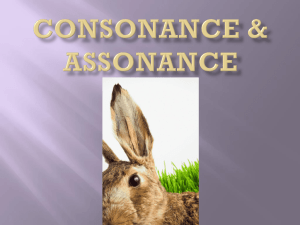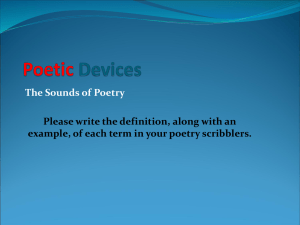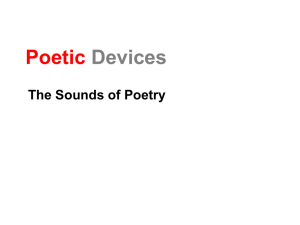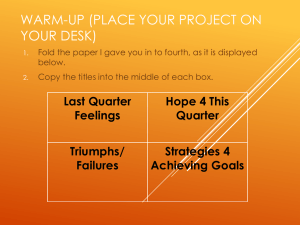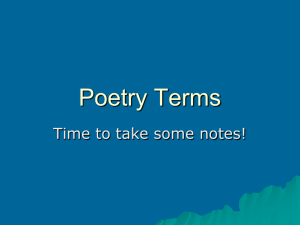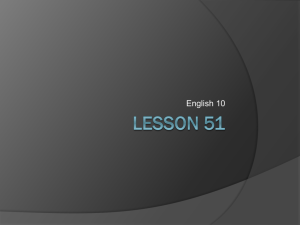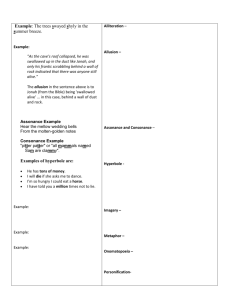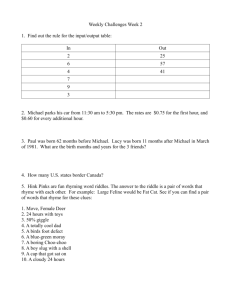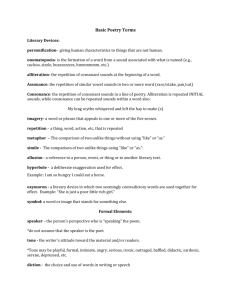Poetry Studies sound
advertisement
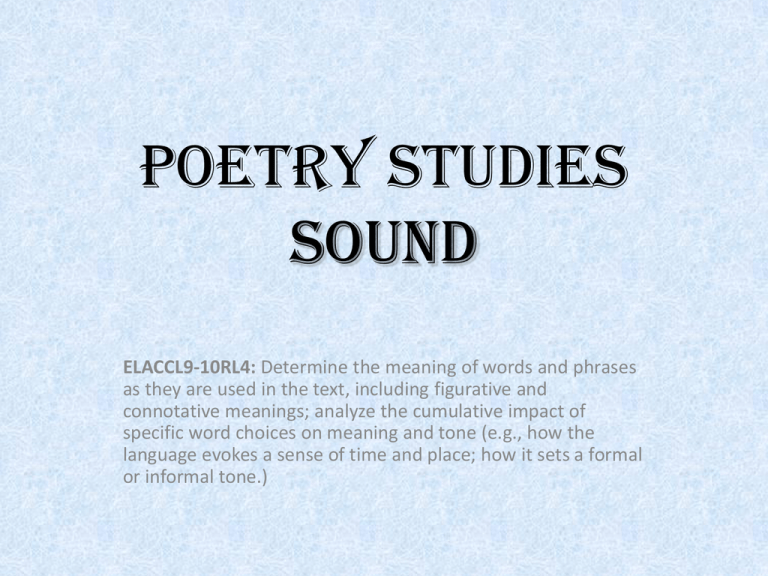
Poetry Studies Sound ELACCL9-10RL4: Determine the meaning of words and phrases as they are used in the text, including figurative and connotative meanings; analyze the cumulative impact of specific word choices on meaning and tone (e.g., how the language evokes a sense of time and place; how it sets a formal or informal tone.) Alliteration Alliteration Definition: The repetition of the same or similar sounds at the beginning of words such as tongue twisters. Examples: • She sells seashells by the seashore • "The mass of men lead lives of quiet desperation." (Henry David Thoreau, Walden) • "A moist young moon hung above the mist of a neighboring meadow." (Vladimir Nabokov, Conclusive Evidence) • "The daily diary of the American dream." (advertising slogan for The Wall Street Journal) Alliteration Tasks • Name places you have visited with alliterative names (example: Hilton Head). • Describe a relative, friend, or classmate in one alliterative sentence. • Using alliteration, write a newspaper headline about a significant event in your life. End Rhyme End Rhyme Definition: Similar sounds which occur at the end of two or more lines of verse. Example: “Bed in Summer” by Robert Louis Stevenson In winter I get up at night And dress by yellow candle-light. In summer quite the other way, I have to go to bed by day. I have to go to bed and see The birds still hopping on the tree, Or hear the grown-up people's feet Still going past me in the street. And does it not seem hard to you, When all the sky is clear and blue, And I should like so much to play, To have to go to bed by day? End Rhyme Tasks • Make a rhyming list of items in your room. • List pairs of two-syllable rhyming words that describe your personality. • Describe your neighborhood using four lines with end rhyme. Internal Rhyme As long as the wrong feels right it’s like I’m in flight Internal Rhyme Definition: Similar sounds which occur between two or more words in the same line of verse (usually at the middle and end of the line); the rhyme comes in the middle of the line rather than the end. Example: "The Raven" by Edgar Allan Poe Once upon a midnight dreary, while I pondered, weak and weary, Over many a quaint and curious volume of forgotten lore, While I nodded, nearly napping, suddenly there came a tapping, As of someone gently rapping, rapping at my chamber door. " 'Tis some visitor," I muttered, "tapping at my chamber door; Only this, and nothing more." Internal Rhyme Tasks • Write four lines that describe your first ride on a bicycle. Use at least two internal rhymes. • Write six lines that describe your opinion on money. All lines must have a word inside them that rhymes with “money.” Only one of those lines can actually use the word “money.” Remember: the rhyming word cannot end the line. Consonance Consonance Definition: It is the repetition of consonant sounds within a line of verse. Consonance is similar to alliteration except consonance does not limit the repeated sound to the initial letter of a word; the repetition generally occurs at the ends of syllables. Consonance is the repetition, at close intervals, of the final consonants of accented syllables or important words , especially at the ends of words. Examples: think blank strong thing pretty little turtles asks fussy questions “Stopping by Woods on a Snowy Evening” by Robert Frost Whose woods these are I think I know. His house is in the village though; He will not see me stopping here To watch his woods fill up with snow. Consonance Tasks • List six pairs of words that describe your favorite type of music. Each word must have the same consonant sound at the end. • Write five non-rhyming lines that use consonance to describe your favorite hobby. Use a different end sound in each line. Assonance Mellow wedding bells Assonance Definition: The repetition or a pattern of similar vowel sounds in the middle of words Examples: strike and grind hat and man "It beats as it sweeps as it cleans." (Advertising slogan for Hoover vacuum cleaners) Strips of tinfoil winking like people ("The Bee Meeting” by Sylvia Plath) Assonance Tasks Write six sentences that include at least two, but no more than three, of the words below. However, the words must come from different columns. You may add 'ing', 'ed' or other endings to some of the words as appropriate. Your final paragraph should relate to your real life. treat wheel peep seen dream feed thief seek feet feel sleep lean stream greed beneath week beat heel creep green scream lead chief weak cheat steal deep queen team need teeth speak heat meal leap jeans steam speed belief cheek meet real sheep mean cream freed underneath beak So, I'm looking for sentences such as: In the middle of the night, a thief came on creeping feet. After the incident, my mom said that I needed to speak to the police chief. Diction Diction Larry diction Definition: the poet's choice of words. The poet chooses each word carefully so that both its meaning and sound contribute to the tone and feeling of the poem. The poet must consider a word's: denotation - its definition according to the dictionary connotation - the emotions, thoughts and ideas associated with and evoked by the word. Examples: Some words are neutral, but can have negative or positive connotations. For example, the word island is neutral. When it refers to a vacation on a Greek island, the word has positive connotations. When it describes being shipwrecked on an island, the word has negative connotations. Also, words associated with smell can be either positive or negative. For example, "scent" is positive, while "odor" is negative. Neutral Positive Negative island vacation shipwrecked smell scent odor teenager young citizen delinquent house home dump Diction tasks • For each of the following words, find a positive and negative counterpart: sound, light, blood, hair, homework, plant. • Decide whether the sentences below are positive or negative in connotation. – I swallowed the mass of mush on my plate. – I savored the combination of flavors on my plate. • For each of the following sentences, change the diction to either a positive or negative tone. – Mike wrote a letter. – The air in the room was warm. – Even though I liked the customer, I could not agree with her reason for exchange. syntax syntax Definition: The grammatical arrangement of words in a sentence; the organization of words, phrases and clauses; the word order. If the order of the words is "wrong," the emotional, psychological, and/or spiritual impact of the words will be lost. After reading the example below you will "feel" the impact of the "right order." "WRONG" ORDER L fourteen I married My Lord, you." "At L "Thirty-five years I lived with my husband." "RIGHT" ORDER "I married you, My Lord, at fourteen." "I lived with my husband for thirty-five years." Examples: In traditional poetry syntax was often altered/reversed in order to facilitate a rhyme scheme such as in this poem by A.E. Housman. 'Among' is thrown to the end of the second line in order to rhyme with 'young'. Modern poets tend not to alter syntax in this way. When I would muse in boyhood The wild green woods among And nurse resolves and fancies Because the world was young… Syntax tasks • Change the order of the following sentences to “regular” word order. – Rarely am I late for my classes. – Hardly a week goes by without a disaster happening in some part of the world. – Seldom have I read such a good book. – Little did we know about what was going on at that time. – Rich as you may be, you can't buy sincere friends. • Write two sentences about your family in which the word order is different from “normal” speech patterns.
